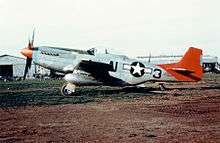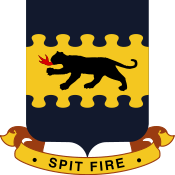William Lee Hill
Major William Lee Hill (Dubie) (1920-1981) from Huntington, West Virginia, was a member of the famed group of World War II-era African-Americans known as the Tuskegee Airmen. He was a recipient of the Congressional Gold Medal in 2007 (Posthumously).[1] Hill was shot down twice during WWII,[2] and he has been given credit for shooting down one enemy plane.[3]
William L. Hill | |
|---|---|
| Birth name | William Lee Hill |
| Nickname(s) | Dubie |
| Born | Huntington, West Virginia |
| Died | Lake Huron, Michigan--> |
| Allegiance | |
| Service/ | United States Army Air Force |
| Years of service | 1943-1964 |
| Rank | Major |
| Unit |
|
| Awards | |
Military service
World War II

December 5, 1943, Hill[5] started training as a U.S. Army Air Corps Cadet in. He received his wings and was sent to the Tuskegee. He had the rank of flight Officer[6], and he received his wings from the Tuskegee Institute and he was assigned to the 332 Fighter Group. Two times Hill's planes were shot down and he suffered severe burns to his body and his face.[2]
Hill has been given credit for shooting down an enemy ME-109 on August 3, 1944.[3] Hill was escorting B-24 bombers to Markersdorf, Germany when his escort mission encountered 14 ME-109s. One of the B-24 bombers was also shot down on that mission.[6]
Hill continued in active service, and in after the war (1947) he was trained as a meteorologist, and served two additional tours overseas. hill achieved the rank of Major and then retired in 1964 from Grand Forks Air Force Base.[7]
Awards
- Congressional Gold Medal (2007)[1][2]
- Air Medal x 3
- Purple Heart
Personal life
Hill grew up in Huntington, West Virginia and had one sister named Lilian.
Further reading
- The Tuskegee Airmen: An Illustrated History, 1939-1949[8]
- Gunston, Bill. Aircraft of World War 2. London: Octopus Books Limited, 1980. ISBN 0-7064-1287-7.
References
- Rangel, Charles B. (April 11, 2006). "Tuskegee Airmen Gold Medal Signed Into Law". Press Release. United States House of Representatives. Retrieved November 26, 2008.
- "Local Tuskegee Airmen honored". HD Media Company, LLC. Herald Dispatch. May 18, 2009. Retrieved August 12, 2020.
- Smith, Erica (September 26, 2009). "Aerial victory credits for the Tuskegee Airmen". STLtoday.com. Saint Louis Post Dispatch. Retrieved August 12, 2020.
- Rice, Markus. "The Men and Their Airplanes: The Fighters." Tuskegee Airmen, 1 March 2000.
- "List of Pilot Graduates". Tuskegee.edu. Tuskegee University. Retrieved August 12, 2020.
- Caver, Joseph; Ennels, Jerome A.; Haulman, Daniel Lee (2011). The Tuskegee Airmen: An Illustrated History, 1939-1949. Ann Arbor, Michigan: NewSouth Books. p. 179. ISBN 9781588382443. Retrieved August 12, 2020.
- Cole, Ronald H. (2006). "Air Power History" (PDF). Black History. 53 (2): 29. Retrieved August 12, 2020.
- Caver, Joseph; Ennels, Jerome A.; Haulman, Daniel Lee (2011). The Tuskegee Airmen: An Illustrated History, 1939-1949. Montgomery: New South Books. p. 394. ISBN 978-1588382443. Retrieved February 6, 2020.
Notes
- The red markings that distinguished the Tuskegee Airmen included red bands on the noses of P-51s as well as a red rudder; their P-51B and D Mustangs flew with similar color schemes, with red propeller spinners, yellow wing bands and all-red tail surfaces.[4]
External links
- Tuskegee Airmen at Tuskegee University
- Tuskegee Airmen Archives at the University of California, Riverside Libraries.
- Tuskegee Airmen, Inc.
- Tuskegee Airmen National Historic Site (U.S. National Park Service)
- Tuskegee Airmen National Museum
- Fly (2009 play about the 332d Fighter Group)
